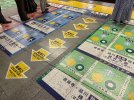I've been trying to scour the internet for this info and can't find anything, I have an interest in timetabling and rail operations and have always been in awe of the Tokaido Shinkansen with its 16 tph and different stopping patterns. What really gets me though is how Hikari and Kodama services are released into the mainline traffic with relatively tiny gaps.
There seem to be instances where Hikari and Kodama services are released into a 6 minute window between two Nozomi trains. Since it takes even the N700 (with it's very quick acceleration for a high speed train) a couple of minutes to get up to line speed it would seem that these slower services would have to depart a station moments after (approx 1 min) a fast service passes though in order to maintain the 3 min headways,
Ultimately what question boils down to this:
Are there provisions for Shinkansen trains, that are accelerating from a stop, to do so with less than what appears to be a standard 3 min headway?
Is 3 min the minimum headway or is this just a timetabling choice and the real minimum headway is shorter?
What are the junction margins for the shinkansen, they appear to be well below the 2/2.5 min that is standard for the UK network?
Does anyone know of any publicly accessible technical documents in English that could shed more light on this, I can find timetables but not much else
There seem to be instances where Hikari and Kodama services are released into a 6 minute window between two Nozomi trains. Since it takes even the N700 (with it's very quick acceleration for a high speed train) a couple of minutes to get up to line speed it would seem that these slower services would have to depart a station moments after (approx 1 min) a fast service passes though in order to maintain the 3 min headways,
Ultimately what question boils down to this:
Are there provisions for Shinkansen trains, that are accelerating from a stop, to do so with less than what appears to be a standard 3 min headway?
Is 3 min the minimum headway or is this just a timetabling choice and the real minimum headway is shorter?
What are the junction margins for the shinkansen, they appear to be well below the 2/2.5 min that is standard for the UK network?
Does anyone know of any publicly accessible technical documents in English that could shed more light on this, I can find timetables but not much else




